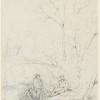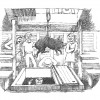There are many interesting issues raised in the writings of the passengers and crew onboard the nine ships we are following here. The journals tells much about the beliefs, hopes and experiences of these people and about the social and economic features of this period as England expanded its empire. Some of these issues and themes are explored in more detail below. You can also use the links in the right hand column to find weekly posts related to the themes, issues and topics listed them.
Issues & themes
British Empire and colonisation
The ships setting sail in 1836 to found the Province of South Australia were part of the global network of trade, communication and governance that was the British Empire.
childbirth in the nineteenth century

When men and women married in 1830s Britain they generally assumed that children would follow promptly and regularly. The prevailing sense was that children just ‘came’ and that there was little to be done about it.
Colonists’ perceptions of Aboriginal people

The diaries of those who make landfall in South Australia in 1836 include a number of observations about the Aboriginal people they encountered, from the women companions of the Kangaroo Island sealers to the ‘Encounter Bay tribe’ (Ramindjeri) and, later, the Kaurna people of the Adelaide plains.
disciplining servants
In the early nineteenth century employers had far greater power to discipline their servants than we would now see as acceptable. In Britain relations between employers and their workers were governed by Masters and Servants Acts.
Faith and providence
Those sailing on the nine ships that left Britain for South Australia between February and July in 1836 came from a society in which faith in the Christian God was a central part of life for the majority of people.
First landings – the story of Elizabeth Beare
History is full of disputed events and the story of the first landing on Kangaroo Island is one of these. In the post for 27 July 1836 we included excerpts from both of the contemporary sources that recorded this event.
Kangaroo Island before 1836

The earliest documented non-Indigenous habitation in what is now known as South Australia was the overwintering in 1803 at American River, Kangaroo Island, of the American brig Union.
livestock on board

The ships that sailed to South Australia in 1836 carried livestock to provide fresh food for passengers in cabin class. Animals included cows, sheep, hogs, sucking pigs, fowls, turkeys, ducks, geese, goats, rabbits and horses.
marriage in 1830s Britain

In early nineteenth century Britain marriage was an assumed goal for both women and men at all social levels. Men sought domestic comfort, companionship, sanctioned sex and the respectability that being a ‘family man’ brought: women sought economic security, companionship and the status accorded to married women.
Religion and the first colonists
The role of religion in the future South Australia was an important preoccupation of members of the various associations promoting the province in the 1830s.
Social hierarchies
Britain in the 1830s was a society structured by rank, wealth and class. The life of a Lord was very different to that of a labourer or milkmaid on his estate, or that of a factory worker. Access to everything from education to political rights was determined by a person’s ‘station in life’ – the social position the person was born into – and wealth.
Whaling

Whaling and sealing were two of the earliest industries developed in Australia. Within a few years of the establishment of the convict settlement at Port Jackson, whaling ventures began to explore coastal waters around New South Wales and Tasmania, sometimes venturing as far as New Zealand.
Share this page:
View journal extracts by ship:
View journal extracts by person:
Recent Comments
- Pam on Joseph and James Jones
- Allison on Africaine passenger list
- Allison on John Pirie
- Judith on John Pirie
- Don Hennig on Cygnet passenger list


Comments or Questions: